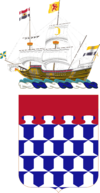
Summary
The 212th Coast Artillery was a Coast Artillery regiment in the New York National Guard.
| 212th Coast Artillery Regiment | |
|---|---|
 Coat of arms | |
| Active | 1921 |
| Country | |
| Branch | New York Army National Guard |
| Size | Regiment |
| Motto(s) | "Pro Patria" (For Country) |
| Commanders | |
| Notable commanders | Colonel Edward E. Gauche |
Lineage edit
Originally organized as 12th New York Volunteer Infantry in 1859, broken up into Pioneer Infantry 4 January 1918. It was reorganized as 212th Artillery (AA)(Coast Artillery Corps), 9 December 1921 as follows:
- HHB- ?
- 1st Battalion from 59th Pioneer Infantry
- 2nd Battalion from 52nd Pioneer Infantry
Redesignated 14 May 1924 as 212th Coast Artillery (AA)
- inducted into federal service 10 February 1941
- 3rd Battalion constituted 27 May 1942 and organized at Seattle, Washington
Regiment broken up 10 September 1943 at Seattle, Washington as follows-
- HHB as HHB 212th Antiaircraft Artillery Group
- 1st Battalion as 773rd Antiaircraft Artillery Gun Battalion
- 2nd Battalion as 212th Antiaircraft Artillery Automatic Weapons Battalion
- 3rd Battalion as 336th Antiaircraft Artillery Searchlight Battalion
- 212th Antiaircraft Artillery Automatic Weapons Battalion redesignated 142nd Antiaircraft Artillery Battalion, 1 February 1949. Redesignated as 642nd Transportation Battalion, 16 March 1959.
- 773rd reorganized and redesignated 16 March 1959 as 212th Artillery, a parent regiment under the Combat Arms Regimental System.
Distinctive unit insignia edit
- Description
A Silver color metal and enamel device 1+1⁄8 inches (2.9 cm) in height overall consisting of a shield blazoned: Vair, a chief nebuly Gules. Attached below the shield a Red scroll turned Silver inscribed “PRO PATRIA” in silver letters.
- Symbolism
The shield of vair represents the allocation of the Regiment to southern New York, as fur constituted a great part of the early trade of this state. Vair originated from the fur of a kind of squirrel (the vair) which was bluey-gray upon the back and white underneath. The red chief is for Artillery and the nebuly partition line is the heraldic symbol for clouds, the field of antiaircraft fire. The motto translates to "For Country".
- Background
The distinctive unit insignia was originally approved for the 212th Coast Artillery Regiment on 25 November 1927. It was redesignated for the 773d Antiaircraft Artillery Gun Battalion on 21 August 1952. It was redesignated for the 773d Antiaircraft Artillery Battalion on 25 March 1958. The insignia was redesignated for the 212th Artillery Regiment on 3 April 1962.
Coat of arms edit
Blazon edit
- Shield
Vair, a chief nebuly Gules.
- Crest
That for the regiments and separate battalions of the New York Army National Guard: On a wreath of the colors Argent and Azure, the full-rigged ship “Half Moon” all Proper. Motto: PRO PATRIA (For Country).
Symbolism edit
- Shield
The shield of vair represents the allocation of the Regiment to southern New York, as fur constituted a great part of the early trade of this state. Vair originated from the fur of a kind of squirrel (the vair) which was bluey-gray upon the back and white underneath. The red chief is for Artillery and the nebuly partition line is the heraldic symbol for clouds, the field of antiaircraft fire.
- Crest
The crest is that of the New York Army National Guard.
Background edit
The coat of arms was originally approved for the 212th Coast Artillery Regiment on 29 November 1927. It was redesignated for the 773d Antiaircraft Artillery Gun Battalion on 21 August 1952. It was redesignated for the 773d Antiaircraft Artillery Battalion on 25 March 1958. The insignia was redesignated for the 212th Artillery Regiment on 3 April 1962.
References edit
- This article incorporates public domain material from websites or documents of the United States Army Center of Military History.
External links edit
- http://www.spanamwar.com/12thNewyork.htm
- Historical register and dictionary of the United States Army, from ..., Volume 1 By Francis Bernard Heitman [1]
- Encyclopedia of United States Army insignia and uniforms By William K. Emerson (page 51).[2]
- [3] Archived 22 May 2011 at the Wayback Machine Field Artillery lineage
- http://dmna.ny.gov/historic/research/AG_Reports/AG_Report_1924.pdf
- Coast artillery Journal March -April 1940 [4]


